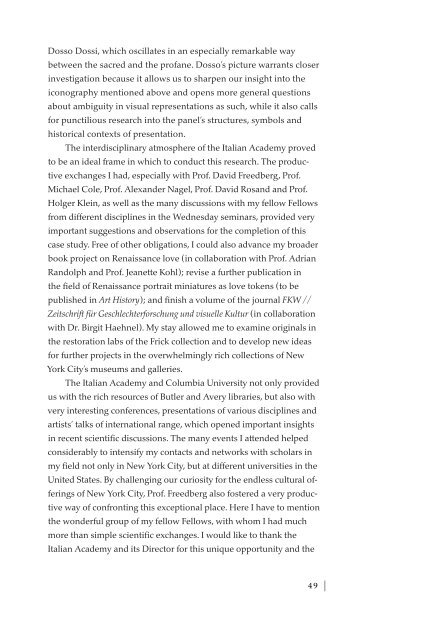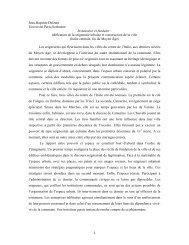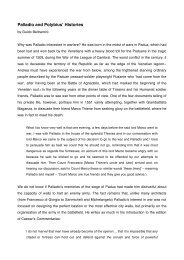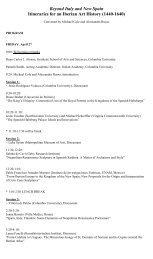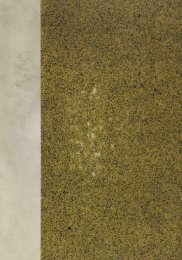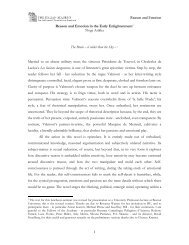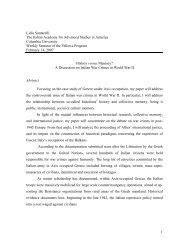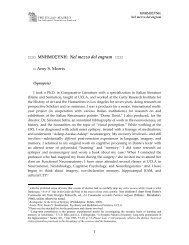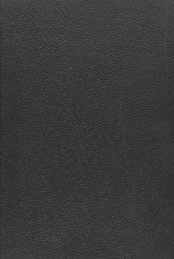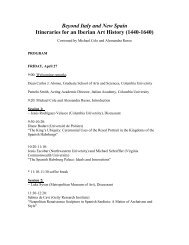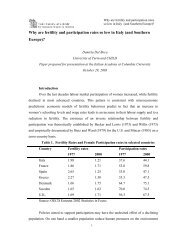2011-2012 - The Italian Academy - Columbia University
2011-2012 - The Italian Academy - Columbia University
2011-2012 - The Italian Academy - Columbia University
You also want an ePaper? Increase the reach of your titles
YUMPU automatically turns print PDFs into web optimized ePapers that Google loves.
Dosso Dossi, which oscillates in an especially remarkable way<br />
between the sacred and the profane. Dosso’s picture warrants closer<br />
investigation because it allows us to sharpen our insight into the<br />
iconography mentioned above and opens more general questions<br />
about ambiguity in visual representations as such, while it also calls<br />
for punctilious research into the panel’s structures, symbols and<br />
historical contexts of presentation.<br />
<strong>The</strong> interdisciplinary atmosphere of the <strong>Italian</strong> <strong>Academy</strong> proved<br />
to be an ideal frame in which to conduct this research. <strong>The</strong> productive<br />
exchanges I had, especially with Prof. David Freedberg, Prof.<br />
Michael Cole, Prof. Alexander Nagel, Prof. David Rosand and Prof.<br />
Holger Klein, as well as the many discussions with my fellow Fellows<br />
from different disciplines in the Wednesday seminars, provided very<br />
important suggestions and observations for the completion of this<br />
case study. Free of other obligations, I could also advance my broader<br />
book project on Renaissance love (in collaboration with Prof. Adrian<br />
Randolph and Prof. Jeanette Kohl); revise a further publication in<br />
the field of Renaissance portrait miniatures as love tokens (to be<br />
published in Art History); and finish a volume of the journal FKW //<br />
Zeitschrift für Geschlechterforschung und visuelle Kultur (in collaboration<br />
with Dr. Birgit Haehnel). My stay allowed me to examine originals in<br />
the restoration labs of the Frick collection and to develop new ideas<br />
for further projects in the overwhelmingly rich collections of New<br />
York City’s museums and galleries.<br />
<strong>The</strong> <strong>Italian</strong> <strong>Academy</strong> and <strong>Columbia</strong> <strong>University</strong> not only provided<br />
us with the rich resources of Butler and Avery libraries, but also with<br />
very interesting conferences, presentations of various disciplines and<br />
artists’ talks of international range, which opened important insights<br />
in recent scientific discussions. <strong>The</strong> many events I attended helped<br />
considerably to intensify my contacts and networks with scholars in<br />
my field not only in New York City, but at different universities in the<br />
United States. By challenging our curiosity for the endless cultural offerings<br />
of New York City, Prof. Freedberg also fostered a very productive<br />
way of confronting this exceptional place. Here I have to mention<br />
the wonderful group of my fellow Fellows, with whom I had much<br />
more than simple scientific exchanges. I would like to thank the<br />
<strong>Italian</strong> <strong>Academy</strong> and its Director for this unique opportunity and the<br />
49 |


